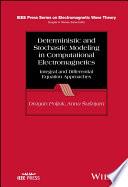DeterministicandStochasticModeling inComputationalElectromagnetics
IntegralandDifferentialEquationApproaches
DraganPoljakandAnna Šušnjara UniversityofSplit Croatia
Copyright©2024byTheInstituteofElectricalandElectronicsEngineers,Inc.Allrightsreserved.
PublishedbyJohnWiley&Sons,Inc.,Hoboken,NewJersey.
PublishedsimultaneouslyinCanada.
Nopartofthispublicationmaybereproduced,storedinaretrievalsystem,ortransmittedinany formorbyanymeans,electronic,mechanical,photocopying,recording,scanning,orotherwise, exceptaspermittedunderSection107or108ofthe1976UnitedStatesCopyrightAct,without eitherthepriorwrittenpermissionofthePublisher,orauthorizationthroughpaymentofthe appropriateper-copyfeetotheCopyrightClearanceCenter,Inc.,222RosewoodDrive,Danvers, MA01923,(978)750-8400,fax(978)750-4470,oronthewebatwww.copyright.com.Requests tothePublisherforpermissionshouldbeaddressedtothePermissionsDepartment,JohnWiley& Sons,Inc.,111RiverStreet,Hoboken,NJ07030,(201)748-6011,fax(201)748-6008,oronline athttp://www.wiley.com/go/permission.
Trademarks:WileyandtheWileylogoaretrademarksorregisteredtrademarksofJohnWiley& Sons,Inc.and/oritsaffiliatesintheUnitedStatesandothercountriesandmaynotbeused withoutwrittenpermission.Allothertrademarksarethepropertyoftheirrespectiveowners. JohnWiley&Sons,Inc.isnotassociatedwithanyproductorvendormentionedinthisbook.
LimitofLiability/DisclaimerofWarranty:Whilethepublisherandauthorhaveusedtheirbest effortsinpreparingthisbook,theymakenorepresentationsorwarrantieswithrespecttothe accuracyorcompletenessofthecontentsofthisbookandspecificallydisclaimanyimplied warrantiesofmerchantabilityorfitnessforaparticularpurpose.Nowarrantymaybecreatedor extendedbysalesrepresentativesorwrittensalesmaterials.Theadviceandstrategiescontained hereinmaynotbesuitableforyoursituation.Youshouldconsultwithaprofessionalwhere appropriate.Further,readersshouldbeawarethatwebsiteslistedinthisworkmayhavechanged ordisappearedbetweenwhenthisworkwaswrittenandwhenitisread.Neitherthepublisher norauthorsshallbeliableforanylossofprofitoranyothercommercialdamages,including butnotlimitedtospecial,incidental,consequential,orotherdamages.
Forgeneralinformationonourotherproductsandservicesorfortechnicalsupport,please contactourCustomerCareDepartmentwithintheUnitedStatesat(800)762-2974,outsidethe UnitedStatesat(317)572-3993orfax(317)572-4002.
Wileyalsopublishesitsbooksinavarietyofelectronicformats.Somecontentthatappearsin printmaynotbeavailableinelectronicformats.FormoreinformationaboutWileyproducts, visitourwebsiteatwww.wiley.com.
LibraryofCongressCataloging-in-PublicationData
Names:Poljak,D.(Dragan),author.| Šušnjara,Anna,author.
Title:Deterministicandstochasticmodelingincomputational electromagnetics:integralanddifferentialequationapproaches/ DraganPoljak,Anna Šušnjara.
Description:Hoboken,NewJersey:Wiley,[2024]|Includesindex.
Identifiers:LCCN2023037537(print)|LCCN2023037538(ebook)|ISBN 9781119989240(hardback)|ISBN9781119989257(adobepdf)|ISBN 9781119989264(epub)
Subjects:LCSH:Electromagnetism–Mathematicalmodels.|Stochasticmodels. Classification:LCCQC760.P6252024(print)|LCCQC760(ebook)|DDC 537.01/515–dc23/eng/20231017
LCrecordavailableathttps://lccn.loc.gov/2023037537
LCebookrecordavailableathttps://lccn.loc.gov/2023037538
CoverImageandDesign:Wiley
Setin9.5/12.5ptSTIXTwoTextbyStraive,Pondicherry,India
Toourbelovedones
Contents
AbouttheAuthors xv
Preface xvii
PartISomeFundamentalPrinciplesinFieldTheory 1
1LeastActionPrincipleinElectromagnetics 3
1.1HamiltonPrinciple 4
1.2Newton’sEquationofMotionfromLagrangian 7
1.3Noether’sTheoremandConservationLaws 8
1.4EquationofContinuityfromLagrangian 12
1.5LorentzForcefromGaugeInvariance 16 References 18
2FundamentalEquationsofEngineeringElectromagnetics 21
2.1DerivationofTwo-CanonicalMaxwell’sEquation 21
2.2DerivationofTwo-DynamicalMaxwell’sEquation 22
2.3IntegralFormofMaxwell’sEquations,ContinuityEquations,and LorentzForce 25
2.4PhasorFormofMaxwell’sEquations 27
2.5Continuity(Interface)Conditions 29
2.6PoyntingTheorem 30
2.7ElectromagneticWaveEquations 32
2.8PlaneWavePropagation 35
2.9HertzDipoleasaSimpleRadiationSource 37
2.9.1Determinationofthe Q-Factor 40
2.10WireAntennasofFiniteLength 41
2.10.1DipoleAntennas 42
2.10.2PocklingtonIntegro-DifferentialEquationforStraightThinWire 43 References 45
3VariationalMethodsinElectromagnetics 47
3.1AnalyticalMethods 47
3.1.1CapacityofInsulatedChargedSphere 47
3.1.2SphericalGroundingResistance 49
3.2VariationalBasisforNumericalMethods 51
3.2.1Poisson’sEquation 51
3.2.2ScalarPotentialIntegralEquation(SPIE) 52
3.2.3CorrelationBetweenVariationalPrincipleandWeightedResidual (Galerkin)Approach 53
3.2.4RitzMethod 53 References 54
4OutlineofNumericalMethods 57
4.1VariationalBasisforNumericalMethods 60
4.2TheFiniteElementMethod 61
4.2.1BasicConceptsofFEM – One-DimensionalFEM 62
4.2.2Two-DimensionalFEM 66
4.2.3Three-DimensionalFEM 73
4.3TheBoundaryElementMethod 77
4.3.1ConstantBoundaryElements 80
4.3.2LinearandQuadraticElements 83
4.3.3QuadraticElements 84
4.3.4NumericalSolutionofIntegralEquationsOverUnknownSources 85 References 86
PartIIDeterministicModeling 87
5WireConfigurations – FrequencyDomainAnalysis 89
5.1SingleWireinthePresenceofaLossyHalf-Space 89
5.1.1HorizontalDipoleAboveaHomogeneousLossyHalf-Space 89
5.1.1.1Integro-differentialEquationFormulation 90
5.1.1.2NumericalSolutionofthePocklingtonEquation 91
5.1.1.3ComputationalExample 95
5.1.2HorizontalDipoleBuriedinaHomogeneousLossyHalf-Space 96
5.1.2.1PocklingtonIntegro-differentialEquationFormulation 97
5.1.2.2NumericalSolutionofthePocklingtonEquation 98
5.1.2.3ComputationalExample 99
5.2HorizontalDipoleAboveaMulti-layeredLossyHalf-Space 100
5.2.1IntegralEquationFormulation 101
5.2.2RadiatedField 106
5.2.3NumericalResults 108
5.3WireArrayAboveaMultilayer 125
5.3.1Formulation 129
5.3.2NumericalProcedures 130
5.3.3ComputationalExamples 133
5.4WiresofArbitraryShapeRadiatingOveraLayeredMedium 150
5.4.1CurvedSingleWireinFreeSpace 154
5.4.2CurvedSingleWireinthePresenceofaLossyHalf-space 155
5.4.3MultipleCurvedWires 156
5.4.3.1NumericalSolutionProcedures 160
5.4.3.2ComputationalExamples 162
5.4.4ElectromagneticFieldCouplingtoArbitrarilyShapedAboveground Wires 166
5.4.4.1FormulationviaaSetofCoupledIntegro-differentialEquations 167
5.4.4.2NumericalSolutionofCoupledPocklingtonEquations 169
5.4.4.3ComputationalExample 170
5.4.5BuriedWiresofArbitraryShape 176
5.4.5.1Formulation 176
5.4.5.2NumericalProcedure 181
5.4.5.3ComputationalExamples 182
5.5ComplexPowerofArbitrarilyShapedThinWireRadiatingAbove aLossyHalf-Space 186
5.5.1TheoreticalBackground 189
5.5.2NumericalResults 193 References 202
6WireConfigurations – TimeDomainAnalysis 207
6.1SingleWireAboveaLossyGround 208
6.1.1CaseofPerfectlyConducting(PEC)GroundandDielectric Half-Space 213
6.1.2ModifiedReflectionCoefficientfortheCaseofanImperfect Ground 214
6.2NumericalSolutionofHallenEquationviatheGalerkin–Bubnov IndirectBoundaryElementMethod(GB-IBEM) 222
6.2.1ComputationalExamples 226
6.3ApplicationtoGround-PenetratingRadar 228
6.3.1TransientFieldduetoDipoleRadiationReflectedfromtheAir–Earth Interface 231
7.3.1TheoreticalBackground 318 x Contents
6.3.1.1NumericalEvaluationProcedure 232
6.3.1.2NumericalResults 234
6.3.2TransientFieldTransmittedintoaLossyGroundDuetoDipole Radiation 235
6.3.2.1NumericalEvaluationoftheTransmittedField 241
6.3.2.2NumericalResults 242
6.4SimplifiedCalculationofSpecificAbsorptioninHumanTissue 246
6.4.1CalculationofSpecificAbsorption 247
6.4.2NumericalResults 249
6.5TimeDomainEnergyMeasures 255
6.6TimeDomainAnalysisofMultipleStraightWiresaboveaHalf-Spaceby MeansofVariousTimeDomainMeasures 260
6.6.1TheoreticalBackground 261
6.6.1.1TimeDomainEnergyMeasuresandPowerMeasure 263
6.6.1.2RootMeanSquareValueofCurrentDistribution 263
6.6.2NumericalResults 264
6.6.2.1Configuration1 265
6.6.2.2Configuration2 267
6.6.2.3Configuration3 270
6.6.2.4Configuration4 270
6.6.2.5Configuration5 272
6.6.2.6Configuration6 277 References 280
7Bioelectromagnetics – ExposureofHumansinGHzFrequency Range 285
7.1AssessmentofSabinaPlanarSingleLayerTissue 286
7.1.1AnalysisofDipoleAntennainFrontofPlanarInterface 287
7.1.2CalculationofAbsorbedPowerDensity 290
7.1.3ComputationalExamples 291
7.2AssessmentofTransmittedPowerDensityinaSingleLayerTissue 295
7.2.1Formulation 296
7.2.2ResultsforCurrentDistribution 300
7.2.2.1ResultsforTransmittedField,VPD,andTPD 301
7.2.2.2DifferentDistancefromtheInterface 302
7.2.2.3DifferentAntennaLength 309
7.2.2.4DifferentFrequencies 316
7.3Assessmentof Sab inaMultilayerTissueModel 318
7.3.2Results 320
7.4AssessmentofTransmittedPowerDensityinthePlanarMultilayer TissueModel 325
7.4.1Formulation 325
7.4.2Results 327
7.4.2.1Two-LayerModel 327
7.4.2.2Three-LayerModel 329
7.4.2.3SkinDepthandSaturationDepth 333 References 337
8MultiphysicsPhenomena 339
8.1Electromagnetic-ThermalModelingofHumanExposuretoHF Radiation 340
8.1.1ElectromagneticDosimetry 340
8.1.2ThermalDosimetry 342
8.1.3ComputationalExamples 346
8.2Magnetohydrodynamics(MHD)ModelsforPlasma Confinement 348
8.2.1TheGrad-ShafranovEquation 348
8.2.1.1AnalyticalSolution 350
8.2.1.2AnalyticalResults 353
8.2.1.3SolutionbytheFiniteDifferenceMethod(FDM) 354
8.2.1.4SolutionbytheFiniteElementMethod(FEM) 356
8.2.1.5ComputationalExamples 358
8.2.2TransportPhenomenaModeling 359
8.2.2.1TransportEquations 361
8.2.2.2CurrentDiffusionEquationandEquilibriuminTokamaks 361
8.2.2.3FEMSolutionofCDE 364
8.2.2.4AnalyticalSolutionProcedure 367
8.2.2.5NumericalResults 368
8.3ModelingoftheSchrodingerEquation 370
8.3.1DerivationoftheSchrodingerEquation 371
8.3.2AnalyticalSolutionoftheSchrodingerEquation 372
8.3.3FDMSolutionoftheSchrodingerEquation 373
8.3.4FEMSolutionoftheSchrodingerEquation 374
8.3.5NeuralNetworkApproachtotheSolutionoftheSchrodinger Equation 375 References 381
PartIIIStochasticModeling 385
9MethodsforStochasticAnalysis 387
9.1UncertaintyQuantificationFramework 388
9.1.1UncertaintyQuantification(UQ)ofModelInputParameters 388
9.1.2UncertaintyPropagation(UP) 389
9.1.3MonteCarloMethod 391
9.2StochasticCollocationMethod 393
9.2.1ComputationofStochasticMoments 393
9.2.2InterpolationApproaches 394
9.2.3CollocationPointsSelection 396
9.2.4MultidimensionalStochasticProblems 397
9.2.4.1TensorProduct 397
9.2.4.2SparseGrids 398
9.2.4.3Stroud’sCubatureRules 399
9.3SensitivityAnalysis 402
9.3.1 “One-at-a-Time” (OAT)Approach 402
9.3.2ANalysisOfVAriance(ANOVA)-BasedMethod 403 References 404
10Stochastic –DeterministicElectromagneticDosimetry 407
10.1InternalStochasticDosimetryforaSimpleBodyModelExposedto Low-FrequencyField 408
10.2InternalStochasticDosimetryforaSimpleBodyModelExposedto ElectromagneticPulse 413
10.3InternalStochasticDosimetryforaRealisticThree-Compartment HumanHeadExposedtoHigh-FrequencyPlaneWave 417
10.4IncidentFieldStochasticDosimetryforBaseStationAntenna Radiation 423 References 430
11Stochastic –DeterministicThermalDosimetry 433
11.1StochasticSensitivityAnalysisofBioheatTransferEquation 434
11.2StochasticThermalDosimetryforHomogeneousHumanBrain 437
11.3StochasticThermalDosimetryforThree-CompartmentHuman Head 447
11.4StochasticThermalDosimetrybelow6GHzfor5GMobile CommunicationSystems 450 References 457
12Stochastic–DeterministicModelinginBiomedicalApplicationsof ElectromagneticFields 459
12.1TranscranialMagneticStimulation 460
12.2TranscranialElectricStimulation 466
12.2.1CylinderRepresentationofHumanHead 467
12.2.2AThree-CompartmentHumanHeadModel 469
12.2.3ANine-CompartmentHumanHeadModel 472
12.3Neuron’sActionPotentialDynamics 481
12.4RadiationEfficiencyofImplantableAntennas 488 References 498
13Stochastic–DeterministicModelingofWireConfigurationsinFrequency andTimeDomain 503
13.1Ground-PenetratingRadar 503
13.1.1TheTransientCurrentInducedAlongtheGPRAntenna 504
13.1.2TheTransientFieldTransmittedintoaLossySoil 508
13.2GroundingSystems 515
13.2.1TestCase#1:SoilAndLightingPulseParametersareRandom Variables 518
13.2.2TestCase#2:SoilandElectrodeParametersareRandomVariables 519
13.2.3TestCase#3:Soil,Electrode,andLightingPulseParametersareRandom Variables 520
13.3AirTrafficControlSystems 523
13.3.1RunwayCoveredwithSnow 526
13.3.2RunwayCoveredwithVegetation 529 References 530
14ANoteonStochasticModelingofPlasmaPhysicsPhenomena 535
14.1TokamakCurrentDiffusionEquation 535 References 543
Index 545
AbouttheAuthors
DraganPoljak (SeniorMember,IEEE)receivedthePh.D.degreeinelectrical engineeringfromtheUniversityofSplit,Croatia,in1996.Heiscurrentlyafull professorwiththeDepartmentofElectronicsandComputing,UniversityofSplit. HeisalsoinvolvedinITERPhysicsEUROfusionCollaborationandinthe CroatianCenterforExcellenceinResearchforTechnologySciences.Hehas publishedmorethan160journalsand250conferencepapersandauthoredsome books,e.g.twobyWiley,Hoboken,NJ,USA,andonebyElsevier,St.Louis,MO, USA.Hisresearchinterestsincludecomputationalelectromagnetics(electromagneticcompatibility,bioelectromagnetics,andplasmaphysics).FromMay2013to June2021,hewasamemberoftheBoardoftheCroatianScienceFoundation.He isamemberoftheEditorialBoardofEngineeringAnalysiswithBoundary Elements,MathematicalProblemsinEngineering,andIETScience,Measurement andTechnology.Hewasawardedseveralprizesforhisachievements,suchasthe URSIYoungScientistsAwardin1999,theNationalPrizeforSciencein2004,the CroatianSectionofIEEEAnnualAwardin2016,theTechnicalAchievement AwardoftheIEEEEMCSocietyin2019,andtheGeorgeGreenMedalfrom theUniversityofMississippiin2021.Heisactiveinafewworkinggroupsof theIEEE/InternationalCommitteeonElectromagneticSafety(ICES)Technology Committee95SC6EMFDosimetryModeling.
Anna Šušnjara receivedherPhDdegreeinelectricalengineeringfromthe UniversityofSplit,Croatia,in2021.Sheiscurrentlyapostdocresearcheratthe FacultyofElectricalEngineering,MechanicalEngineeringandNavalArchitecture,UniversityofSplit.Herresearchinterestsincludenumericalmodeling, uncertaintyquantification,andsensitivityanalysisincomputationalelectromagnetics.Dr. ŠušnjaraisinvolvedinITERphysicsEUROfusioncollaboration.From 2015to2021,shewasamemberofEUROfusionworkpackageforcodedevelopmentinEuropeanTransportSolver(ETS),whilefrom2021,shehasbeena memberofIFMIF-DONESproject.Dr. ŠušnjaraisamemberofIEEEandBIOEM
societies.ShecurrentlyservesasVicePresidentofIEEEEMCCroatianchapter.To date,Dr. Šušnjarahas(co)authored19journalandmorethan40conference papers.Sheservesasareviewerforsevenjournalsandtwoconferences. Dr. Šušnjaragavelecturesaboutcomputationalelectromagneticsatseveral Europeanacademicinstitutionsandtutorialsatinternationalscientific conferences.Shewasawardedseveralprizesforherachievements.In2023,she receivedtheURSIYoungScientistAwardatthe35thURSIGASSinSapporo, Japan.ShewasalsoawardedtheNationalPrizeforScienceandtheUniversity ofSplitPrizeforSciencein2021and2022,respectively.In2016,shereceived thebestposterpaperawardatBioEMconferenceinGhent,Belgium,andspent onemonthatPolitecnicodiTorinoasSPI2016YoungInvestigatorTraining Programawardee.
Preface
Mostofthecomputationalmodelsusedinengineeringelectromagneticsare deterministicinnature,i.e.onedealswithanexactsetofinputdatainasense ofeithermaterialpropertiesorgeometry.However,inmanyscenarios,there areproblemswithuncertaintyintheinputdatasetassomesystemproperties arepartlyorentirelyunknown.Therefore,astochasticapproachisrequiredto determinetherelevantstatisticsaboutthegivenresponses,thusprovidingthe assessmentoftherelatedconfidenceintervalsinthesetofnumericalresults obtainedasanoutputofagivendeterministicmodel.Ofparticularinterestare nonintrusivestochasticapproachesthatcouldbeeasilycoupledwithwidelyused well-establisheddeterministicmodels,byefficientlypostprocessingnumerical resultsarisingfromdeterministicmodels.
Thegoalofthisbookistodemonstratetheefficiencyofparalleluseofdeterministicandstochasticmodelsfeaturingcombinationofwell-establishedanalytical/ numericalmethodswithstochasticanalysistechniques.Thenonintrusivestochasticapproachpresentedinthebookcanbereadilyincorporatedintomajorityof computationalelectromagnetics(CEM)modelswithlittleeffortaimingtoquickly provideamoredetailedinsightintotherelationshipbetweentheinputparameters andtheoutputofinterest.
Avarietyofexamplesthroughoutthebookarepresentedtoclearlydemonstrate theefficiencyofdeterministic-stochasticapproachesinCEMmodels,andareferencelistisgivenattheendofeachchapter.Thebookprovidescomputational examplesillustratingsuccessfulapplicationofstochasticcollocation(SC)techniqueintheareasofground-penetratingradars(GPRs),groundingsystems,radiationfrom5Gsystems,humanexposuretoelectromagneticfields,transcranial magneticstimulation(TMS),transcranialelectricstimulation(TES),transient analysisofburiedwires,anddesignofinstrumentallandingsystem(ILS).
Thebookisdividedintothreeparts.PartIoutlinesthefundamentalsof classicalelectromagneticsandbasicsofnumericalmodeling.PartIIdealswith deterministicmodelspertainingtoanalysisofthinwiresinbothfrequencyand
xviii Preface
timedomains,humanexposuretoelectromagneticfieldsinGHzfrequencyrange, andmultiphysicsphenomenasuchasplasmaconfinementintokamak.Finally, PartIIIisentirelydevotedtostochasticmodelingcoveringadetaileddescription ofSCmethodandsensitivityanalysis.PartIIIalsocontainsanumberofapplicationsarisingfromelectromagnetic-thermaldosimetry,biomedicalapplications, electromagneticcompatibility(EMC),GPRs,groundingsystems,airtrafficcontrol systems,andtransportphenomenaintokamak.
Thematerialgiveninthisbookisdominantlybasedonpaperspreviouslypublishedbytheauthors,suitablymodifiedtopresenttheresultsinauniformdesign andformat.Additionalrelatedmaterialisplannedtobepreparedaimingtocompletesomedetailsandextensionsofthepublishedwork.Anextensivereference listofotherrelatedworkisalsoincluded.Thegoalistoprovideareferenceon thedeterministic-stochasticmodelingindifferentareasofCEMcoveringfrequencyandtimedomainanalysesofwireantennasandtheirvariousapplications, EMC,computationalmodelsoflinesandcables,lightning,groundingsystems, GPRs,magnetohydrodynamics,bioelectromagnetics,andbiomedicalapplications ofelectromagneticfields.
Asthebookcoversmultidisciplinaryphenomena,suchaselectromagneticthermaldosimetry,magnetohydrodynamics,andplasmaphysics,theauthors hopeitcouldbeofinteresttomultidisciplinaryresearchers,engineers,physicists, andmathematicians.
TheAuthors Split,Croatia,2023
LeastActionPrincipleinElectromagnetics
Lawsofnaturearegovernedbyfollowingfundamentalprinciples – theaction principle,locality,Lorentzinvariance,andgaugeinvariance[1].Hamilton’sprinciple,ortheleastactionprinciple,isoriginallydevelopedforclassicalmechanics statingthataparticle,amongallofthetrajectoriesbetweenfixedtimeinstants t1 and t2,followsthepathwhichminimizesthe action.Actionisdefinedastimeintegralofthedifferencebetweenthekineticenergyandpotentialenergy,respectively.Thus,Hamilton’sprinciplesomehowrequiresthetimeaveragesofthe kineticenergyandpotentialenergytodistributeasequallyaspossible(equipartition)[2].Inclassicalmechanics,Hamilton’sprincipleandNewton’ssecondlaw representequivalentformulations.
AnextensionofHamilton’sprinciplefromclassicalmechanicstoclassicalelectromagneticscanbeundertakenstartingwiththeanalysisofthemotionofsingle chargedparticle[3].NextstepistoconstructaLagrangianfortheelectromagnetic fieldbyextendingtheLagrangianpertainingtoclassicalmechanics.FromthecorrespondingLagrangians,featuringNoether’stheoremandgaugeinvariance,itis possibletoderiveequationofcontinuityforthecharge,Lorentzforce,and Maxwell’sequations,whichcanbefoundelsewhere,e.g.[2–5].
Generally,whenafunctionalisextremal,Noether’stheoremyieldstheconservationlaw.Thus,invarianceofthesystemunderatimetranslationresultsinthe energyconservation.Itisalsoworthnotingthatspacetranslationinvariance correspondstotheconservationoflinearmomentum,rotationinvariancecorrespondstotheconservationofangularmomentum,whilegaugeinvarianceyields thechargeconservation[1,2].
Thesederivationsarerecentlyreviewedin[6–8].
ThischapterfirstdealswithderivationofcontinuityequationandLorentz force,andaderivationofMaxwell’sequationsfromtheelectromagneticfield
DeterministicandStochasticModelinginComputationalElectromagnetics:IntegralandDifferential EquationApproaches,FirstEdition.DraganPoljakandAnna Šušnjara.
©2024TheInstituteofElectricalandElectronicsEngineers,Inc. Published2024byJohnWiley&Sons,Inc.
4 1LeastActionPrincipleinElectromagnetics
functionaliscarriedout.Finally,avariationalbasisofnumericalsolution methodsinelectromagneticsisdiscussed.
1.1HamiltonPrinciple
Hamiltonvariationalprinciplerepresentsnotonlythebasisofmodernanalytical dynamicsbutalsoofuniversalphysicallaws,i.e.fundamentallawsofclassical physicscanbeunderstoodintermsofaction.
ThissectionfirstdealswithHamilton’svariationalprincipleinmechanics, Newton’sequationofmotion,andNoether’stheorem.Thenthevariational principleinelectromagneticsisdiscussed.
Forsimplicity,asystemwithonedegreeoffreedomrepresentedbyageneralized coordinate q isconsideredtogetherwithrelatedfunctionofposition,velocity,and time Lq, q, t where q denotesthetimederivative.
Thetaskistodeterminehowapointparticleshouldmoveinthisonedimensionalspacesothatthetimeintegralof L isminimizedcomparedwith theintegralovertheconceivablepathsbetweenthesamestartingandendpoints, asdepictedinFig.1.1.Thesolutionisgivenbystating q asafunctionoftime q = q(t).
Tocompareallpathshavingthesamestartingandendpoints,thevariationof function q iszeroatbothends[1–4]
i.e.allalternativesstartatinstant t1 andarrivetogetheratinstant t2.
Theminimumconditionisthengivenbyafunctional F expressedintermsofthe integral[1–4]
Figure1.1 Thevariedfunction q(t).
Inclassicalmechanics,function L isreferredtoasLagrangianandisexpressedas L = W kin W pot
3 where Wkin and Wpot arethekineticenergyandpotentialenergy,respectively. Accordingtothecalculusofvariation,thefunctionalapproachesminimumvalue
whenitsvariationvanishes,i.e.:
whichcanalsobewrittenas
Therefore,function q(t)minimizesfunctional(1.2)or(1.4),respectively,andit follows
Forthesimplestcasegivenby Lq, q, t thevariationoffunction L isgivenby
Andbyperformingsomefurthermathematicalmanipulation,onereadily obtains
As δq =0attheendsofthepath,thesecondtermattheright-handsideautomaticallyvanishes. 1.1HamiltonPrinciple 5
Furthermore,accordingtothe fundamentallemma ofvariationalcalculus[4] thefirstintegraltermattheright-handsideof(1.9)vanishesifthefollowingconditionissatisfied
ItisworthnotingthatthesecondorderdifferentialEq.(1.10)relatestheposition q forthetime t,andalsodeterminesthetruepathofthesystemwhentwoend positionsandtimesaregiven.ThisequationisknownasLagrange–Eulerequation ofmotion[1,2].
Inthecaseofasinglefunctionofmultiplevariables, Lqk , qk , ξ, t (1.10)becomes
Finally,iffewfunctionsofmultipleindependentvariables Lqk
considered,itfollows
which,forexample,pertainstothree-dimensionalproblemsinelectromagnetics.
Hamiltonvariationalprinciplecanbeconsideredagenerallawnotonlyfor particledynamicsbutalsoforthedynamicsofcontinuousmaterials.
Anextensiontothree-dimensionalproblemsincontinuousmaterials,i.e.for physicalfields,thevariationalprinciplecorrespondingtoEq.(1.6)isgivenby
where Ld istheso-calledLagrangedensitydefinedas
andhasaunitofenergypervolume.
Itisworthnotingthatthevariationalprincipleisaninvariantforcoordinate transformations[1].
1.2Newton’sEquationofMotionfromLagrangian 7
1.2Newton ’sEquationofMotionfromLagrangian
Lagrangianinclassicalmechanicsforaparticlewithmass m withdisplacement r
attime tL0 r , dr dt , t isoftheform
where dr dt istheparticlevelocityand W pot r standsforpotentialenergy(notdue toelectromagneticfield).
Thecorrespondingaction F0 relatedtoLagrangian(1.15)isgivenbyintegral
Nowvaryingtheaction(1.16)
Itcanbewrittenas:
anditfollows:
whichsimplygives:
Ifmass m isregardedasconstantquantity,right-handsideof(1.21)represents thecomponentsofmechanicalforce:
Asthemechanicalforceisdefinedasanegativegradientofthepotentialenergy
onesimplyobtainsasetofNewton’sequationsofmotion
wheretheright-handsideof(1.24)representsaforceactingontheparticle.
1.3Noether’sTheoremandConservationLaws
Therearephysicalquantitiesthatdonotchangethroughoutthetimedevelopment ofphysicalsystems.Thesequantitiesarestatedtobeconservedundercertainconditionswhicharegovernedbyconservationlaws.Itcanbeshownthatconservationlawsareaconsequenceofthesymmetrypropertiesofaphysicalsystem (invariancepropertiesofasystemunderagroupoftransformations[2,9]).The symmetrypropertiesofthesystemandconservationlawsareconnectedwith Noether’stheorem,e.g.[2,9].
Let uk(x)(k =1,2,…n)beasetofdifferentiablefunctionsoftheindependentvariable x andlet vk(x)bethefirstderivatives,i.e.itcanbewrittenas
NowLagrangian L isdefinedasafunctionof x,and n functionsof uk and n functionsof vk
Ifoneconsidersaninfinitesimaltransformation T
1.3Noether’sTheoremandConservationLaws 9
Furthermore,under T,oneconsequentlyhas:
Nowassumingthefunctional S = Ω Ldx
tobeinvariantunder T sothatthetransformation(1.30)whichmapstheinterval Ω into Ω doesnotchange,itfollows
Performingsomemathematicalmanipulations,oneobtainsthefollowing expression
Finally,Noether’stheoremstatesthatiffunctional S isinvariantundertheinfinitesimalone-parametergroupoftransformations T,thenthesetof n equations
simplygives
i.e.itcanbewrittenas
namely,theexpressionisindependentof x variable.
Ontheotherhand,Newton’sequationofmotioncanbeexpressedintermsof Lagrangianbeingafunctionofthegeneralizedcoordinates qk (k =1,2, …, n)and theirderivatives,i.e.
whichisequivalenttotherequest
Furthermore,Hamilton’sprinciple(theleastactionprinciple),whichstates thatsolutions qk ofthesystemofmasspointsforwhichtheintegralin(C6)is anextremumcontrarytoallfunctions qk
Ifonecompares(1.34)with(1.35)with δx =0and δuk =0,itfollowsthatthese statementsareidenticalNamely,itcanbewrittenas
i.e.theleft-handsideisaconstantofmotion.
Asanytimetranslationisexpressedas δt 0and δqk =0,thefollowingexpressionisobtained
statingthatHamiltonian H whichisequaltothetotalenergyofthesystem(sumof kineticenergyandpotentialenergy)isconstantofthemotion.
Inotherwords,timetranslationsymmetrycorrespondstotheconservationof energy.Therefore,Noether’stheoremstatesthatforasystemwithtimetranslation symmetry,theenergyofthesystemisconserved.
TheenergyconservationcanbedemonstratedbyusingLagrangianand Hamiltonianinclassicalmechanicsforone-dimensionalcase.
Thus,Lagrangianisoftheform
whileHamiltonianofthesystem,accordingto(1.40),isthen











